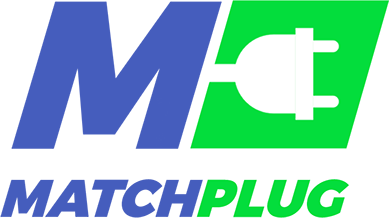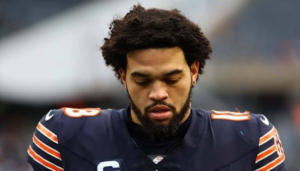Tell us, how do you read betting odds?
Understanding how to read odds is a vital step you must take if you want to become a successful sports bettor. With a solid interpretation of the odds, you can easily determine how much money you should wager, the bets that have the most value, and what you’ll earn in payouts.
Teaching yourself how to read betting odds is a step you can’t miss if you truly want to become an expert bettor. While a few bettors think of this as being challenging, by investing time and enough practice, you can soon start reading odds.
This article educates new punters like you about how to read, understand, and interpret betting odds and; more importantly how to make a profit with this skill.
See: Betting Basics: Optimizing Your Betting Selections
Types Of Betting Odds
There are three major types of betting odds – Money line (American, Fractional (British), and Decimal (European)odds. These are simply different ways of displaying the same odds and have no difference in terms of payouts.
Fractional odds are the ratio of the amount (profit) won to the stake, decimal odds represent the amount you win for every $1 you wager, and money line odds depending on the negative or positive sign, show the amount you wager to win $100 or amount to win for every $100 you stake.
What are Money Line, Decimal, and Fractional Betting Odds?
When odds are represented in moneyline, decimal, or fractional formats, they are that way for two reasons:
- To signal the implied probability of the outcome they are attached to.
- Indicate how much money bettors could win betting on that outcome.
Money Line Odds
Money Line or American betting odds are displayed as any three-digit number with a plus (+) or minus (-) sign in front of it; +150 -200, etc.
The plus and minus signs on a betting line show your prospective payout and if you’re backing favourites or underdogs.
The favourites are identified by negative numbers, this number indicates the amount of money you should bet to win $100.
Positive numbers represent underdogs and show the amount of money you’ll win if you wager $100.
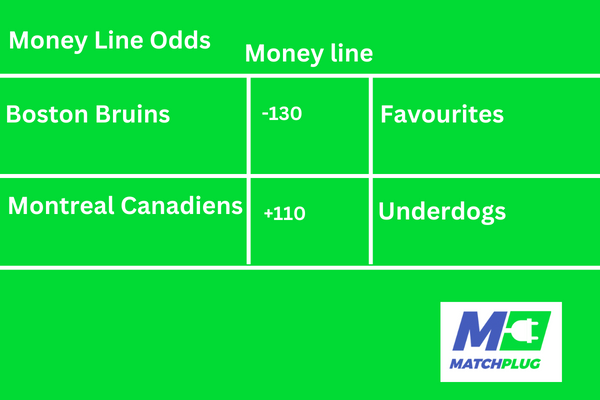
Most prominent wagers including many points spread bets have two sides with negative odds. This is because point spread aims at levelling the playing field between both sides.
Calculating Winnings With Money Line Odds
To win $100 on the favourites (Bruins), you need to wager $130. For the underdogs (Canadiens) a wager of $100 will win you $110.
For a wager of $40 on Boston (-130), the equation looks like this:
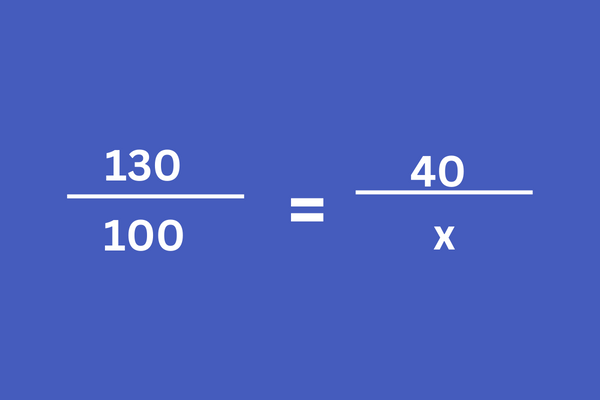
- Cross-multiply for 130x = 4000 and solve for ”x”
- x= 4000/130
- x= 30.77
A $40 bet on Boston wins you $30.77 and you get a $70.77 payout (original wager + winnings).
Betting $40 on Montreal (+110) the equation will look like this:
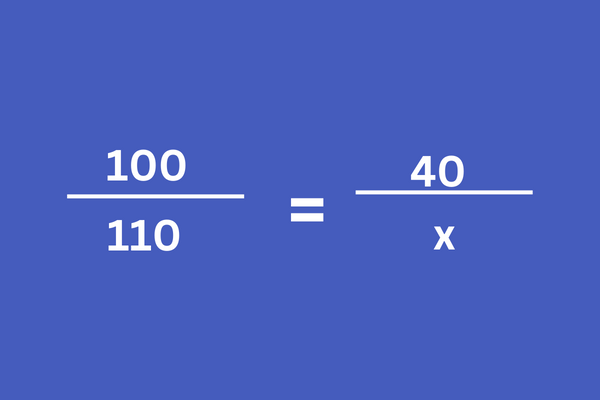
- Cross-multiply for 100x = 4,400 and solve for ”x”
- x= 4000/100
- x= 44.00
A wager on Montreal gets you $44.00, the total payout is $84.00.
Calculating Implied Probability With Money line Odds
Implied probability is the likelihood of an outcome given by the odds. To solve it, you’ll convert odds into a percentage, indicating the likelihood an event will happen vs. the alternative.
This concept is important because if your estimate of the probability of an event happening differs from a sportsbook’s you can adjust your bet accordingly. E.g if a team had a 60% chance of winning and its implied probability was 52.4%, it would be a smart wager.
The formula for calculating implied probability is:
- Risk/Return = Implied Probability
In American odds implied probability can be used in positive and negative odds.
Formula For Positive Odds:
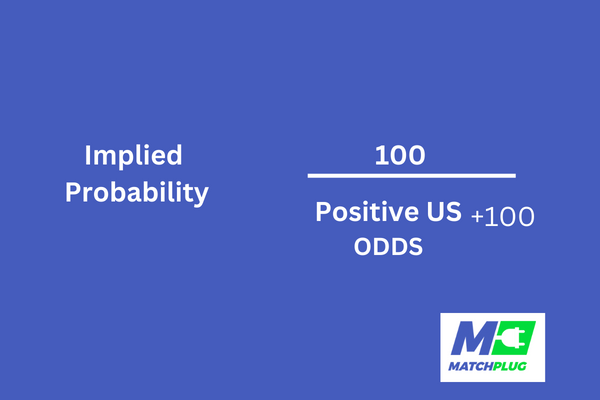
This formula can also calculate Montreal’s (+100) implied probability of winning the game.
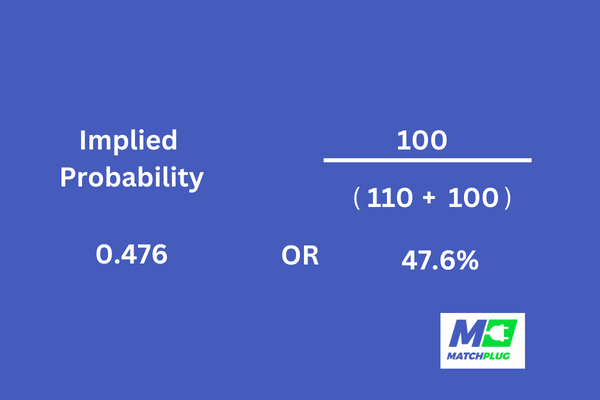
From the equation, Montreal has a 47.6% chance of winning.
Formula For Negative Odds:
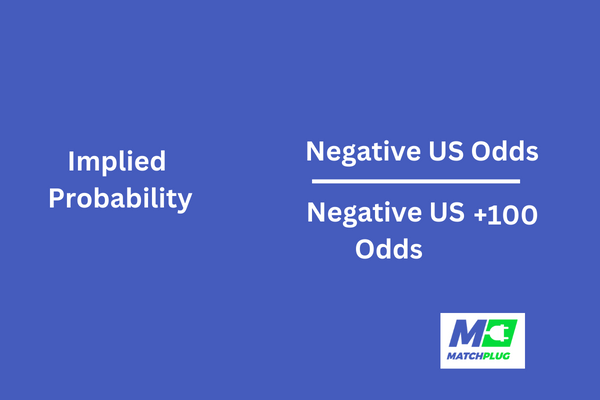
Boston’s (-130) implied probability of winning the match, can be calculated with the above example.
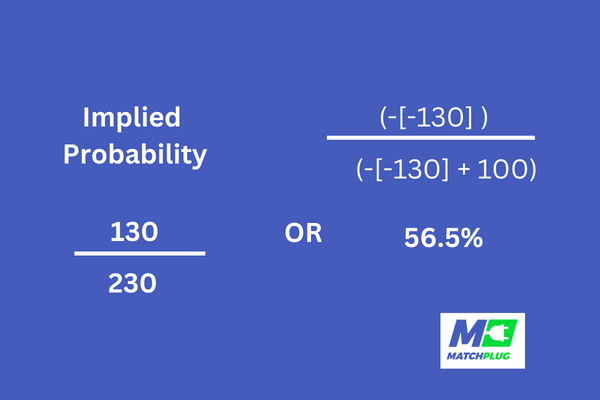
The bookmaker predicts that Boston has a 56.5% chance of winning the game.
See also: Betting Basics: How Do Bookmakers Make Their Money?
Decimal Odds
Decimal or European odds are the easiest betting odds to work with, and are displayed like this:
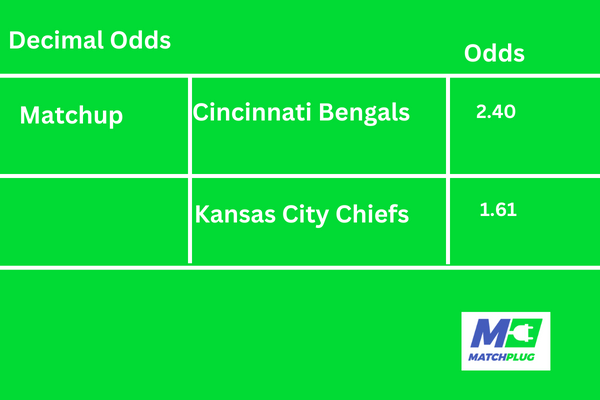
Calculating Winnings With Decimal Odds
To determine your payout with decimal odds, just multiply your wager by the odds assigned to the team you’re backing. For calculating winnings, subtract the original wager from the payout.
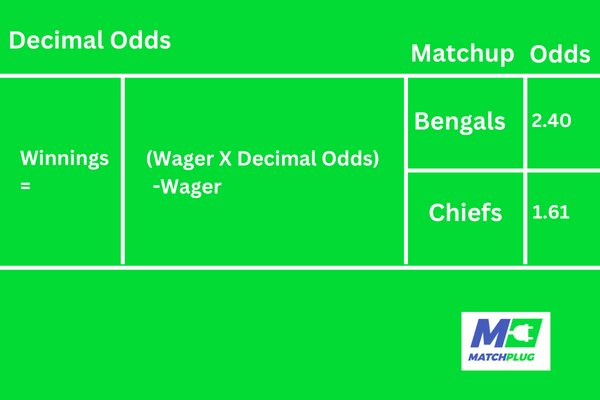
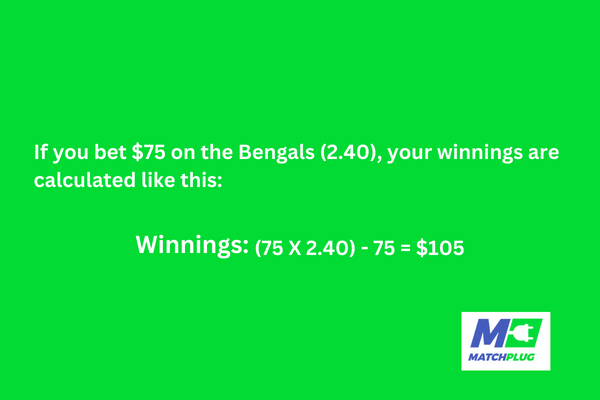

Calculating Implied Probability
Use this formula to get the implied probability of decimal odds.
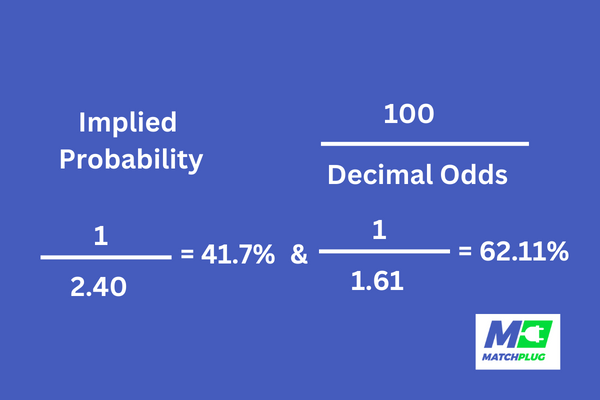
- Implied Probability: 1/Decimal Odds
The equation below provides Kansas’ implied probability of winning:
- Implied Probability: 1/2.40 = 41.7%
Cincinnati’s chances of winning:
- Implied Probability: 1/1.61 = 62.11%
Fractional Odds
Fractional or UK betting odds are popular in the UK and are used to bet on horse races. These odds are represented as – 9/5 or 1/2. When pronouncing the odds you’d say ”nine to five” or ‘one to two.”
In fractional odds, the number on the left determines how many times bookies expect an event’s outcome to fail, while the number on the right is how many times the outcome is expected to succeed.
How Fractional Odds Work
If Oleksandr Usyk gets 8/13 odds for an upcoming fight with Anthony Joshua, the odds state that if their fight happened 21 times (8+13), Usyk would lose 8 matches and win 13.
The implied probability of Usyk winning is calculated by the number of times he is predicted to win (13) divided by the total number of trials (21). This gives Usyk a 61.9% chance to win the fight.
Look at the math below:
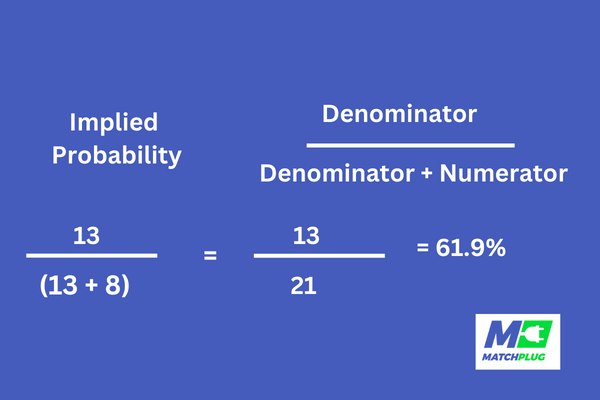
To calculate Joshua’s probability of winning the fight, you’d use the same equation. If the odds are 11/8, and the fight happened 19 times (11+8), Joshua will lose 11 times and win 8 times. The probability will be 8 divided by 19. Joshua gets a 42.1% chance of winning the fight.
The formula looks like this:
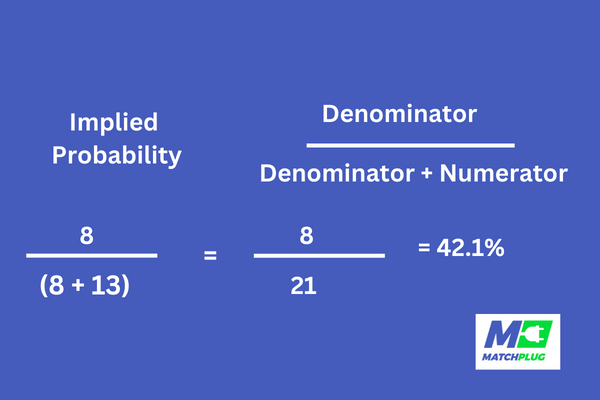
Without factoring in the probability of a draw, the total of the probabilities is already past 100% (61.9 + 42.1 = 104). The implied probability of the two outcomes when summed up will be over 100% no matter the odds format.
If Usyk is your favourite (8/13), multiply your wager by the quotient of 8 ÷ 13 (0.615) to calculate your winnings. A $10 bet, provides winnings of $6.15 (10 x 0.615). In which case you get $16.15 back ($10 bet + $6.15 winnings).
Follow this formula:

When betting $10 on Joshua, multiply that amount by the quotient of 11 ÷ 8 (1.375). Winnings would be $13.75 ($10 x 1.375). Your payout sum would be $23.75 ($10 initial stake + $13.75 winnings).
Use this formula:
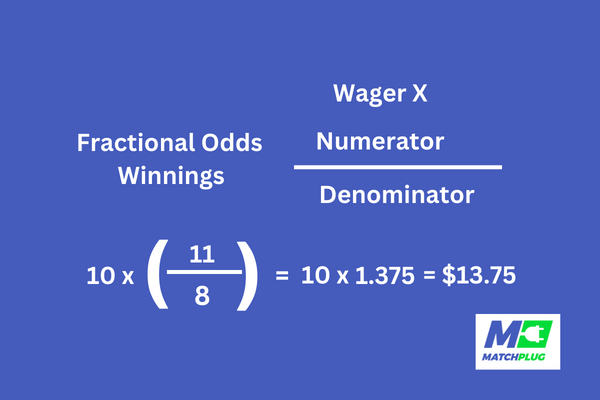
How Do Betting Odds Correlate With Payouts?
Betting odds are tools that disclose oddsmakers’ stances on a match, event, or proposition. They indicate how much money you’d stake to win a stated amount.
Commonly Used Sports Betting Odds
There are a few common points spreads, money lines, and odds that you’d see in sports betting, we laid them out below, including what they mean.
1. +7 Spread
A team with a +7 spread is simply the 7-point underdog. When backing underdogs, they need to win outrightly or lose by 6 points or fewer.
If they lose by 7 points it becomes a push (tie) and you get your money back.
2. +4.5 Spread
The +4.5 spread represents a 4.5-point underdog. For this odd, there is no push. If the 4.5-point underdog wins the game or loses by four points or lower, it “covers the spread.”
But if they lose by 5 points or more, it doesn’t cover the spread. When a half-point is included in a point spread, there is a final winner and no tie.
3. +350 Odds
These are money line odds that show the team as a significant underdog, with a 22% implied probability of winning.
If this underdog pulls off an upset and you backed $100 on them, you’ll get a $350 payout (plus your initial $100 stake).
4. +125 Odds:
Teams with odds of +125 are small (short) money-line underdogs. Betting $100 on them yields a $125 profit.
5. 20-to-1
20-to-1 odds indicate a long shot that’ll probably not win. The implied probability of winning for a team that is 20-to-1 is 4.76%.
But, if this long shot is a winner, it’d pay %20 for every $1 wagered. That means a $1,000 bet on a 20-to-1 shot brings a profit of $20,000.
6. 30-to-1
30-to-1 is the same as 20-to-1 but for a bigger underdog. The implied probability for a win shifts to 3.23% but with a larger payout potential.
7. +600 Odds
+600 odds are money-line odds for a big underdog that pays $600 on a winning $100 wager.
8. +1200
This is another Moneyline odds for a heavy underdog. A $100 bet on a team at +1200 means a payout of $1,200 if it wins.
9. Minus 160
“Minus 160” refers to a simple money line favourite. You’d need to stake $160 to win $100 on a -160 favourite.
10. +700
Teams that are +700 in a match are underdogs with 7/100 odds of winning. A $100 wager pays out $700.
11. +900
Backing a team with +900 means you’d win $900 for each $100 you bet. This odd is considered to be a sizeable underdog in sports betting at 9/1.
12. +600
Teams with +600 are big underdogs. However, $100 stakes on them would return $600 for the risk of backing a team 6/1
Frequently Asked Questions About Reading Betting Odds
For this section, we have compiled a list of some frequently asked questions about reading odds which you might have, and their answers too.
1. What Is The Vigorish?
A vigorish (vig or juice) is the amount a bookmaker charges you for placing your bet. It’s their commission for services they provided to you.
Vig amounts are different across sports and wagers, and you can’t easily determine vig by reading odds.
2. What Is Chalk In Sports Betting?
“Chalk” in sports betting addresses a team that is favoured on the odds board; the heavy favourite. Small chalk, on the other hand, refers to the slight favourite.
3. What Does A Pick’em Mean?
A pick’em means a match that has no favourite or underdog. Both sides are viewed as equals and no point spread is listed.
There are two ways bettors can spot a pick’em:
First, the money line odds are the same for the two teams – they’ll be listed at +100 (+100 is the sports betting equivalent of ”even”).
Pick’em point spreads, have the regular number on the betting board – for example, -2 or +4.5 replaced by the two letters PK.
At sportsbooks, are pick’em looks like this:
- Team A (-110) vs. Team B (-110)
- Team A (+100) vs. Team B (+100)
- Team A (PK) -110 vs. Team B (PK) – 110
4. What Are 7 To 2 Odds?
7 to 2 odds show that every $2 wager can win you $7 if the bet is a winner. In fractional odds, the number on the left represents how much you win, and the one on the right indicates how much you should stake.
5. What Does +200 Mean For Odds?
As a Money line odd +200 expresses the amount you could win if you stake $100. If the bet works, you’ll get a total payout of $300 ($200 net profit + $100 initial stake.
6. What Are Vegas Odds?
Sportsbooks used vegas odds. Money lines, point spread, and the total number of points the bookmaker predicts to be scored are all incorporated into this odd.
Vegas odds allow bettors to bet over or under bookmakers’ scores and select what they believe the difference in points will be.
Now that you have acquired enough knowledge on reading betting odds, you can show off your expertise, by placing wagers to start winning some money on your favourite Prediction site.
Further Reading:
